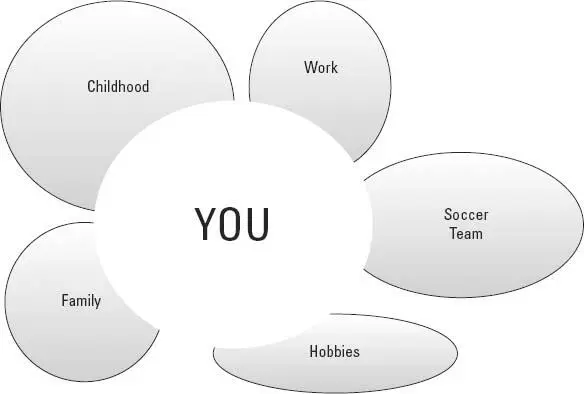Bruce Hood - The Self Illusion
Здесь есть возможность читать онлайн «Bruce Hood - The Self Illusion» весь текст электронной книги совершенно бесплатно (целиком полную версию без сокращений). В некоторых случаях можно слушать аудио, скачать через торрент в формате fb2 и присутствует краткое содержание. ISBN: , Издательство: Constable & Robinson, Жанр: Старинная литература, на английском языке. Описание произведения, (предисловие) а так же отзывы посетителей доступны на портале библиотеки ЛибКат.
- Название:The Self Illusion
- Автор:
- Издательство:Constable & Robinson
- Жанр:
- Год:неизвестен
- ISBN:9781780331379
- Рейтинг книги:5 / 5. Голосов: 1
-
Избранное:Добавить в избранное
- Отзывы:
-
Ваша оценка:
- 100
- 1
- 2
- 3
- 4
- 5
The Self Illusion: краткое содержание, описание и аннотация
Предлагаем к чтению аннотацию, описание, краткое содержание или предисловие (зависит от того, что написал сам автор книги «The Self Illusion»). Если вы не нашли необходимую информацию о книге — напишите в комментариях, мы постараемся отыскать её.
The Self Illusion — читать онлайн бесплатно полную книгу (весь текст) целиком
Ниже представлен текст книги, разбитый по страницам. Система сохранения места последней прочитанной страницы, позволяет с удобством читать онлайн бесплатно книгу «The Self Illusion», без необходимости каждый раз заново искать на чём Вы остановились. Поставьте закладку, и сможете в любой момент перейти на страницу, на которой закончили чтение.
Интервал:
Закладка:
Why is it so difficult to see through the illusion? The answer may have something to do with reflections in one form or another that have popped up throughout this book. Think back over all the examples:
• Babies and animals recognizing themselves in mirrors
• Brain-damaged adults with mirror misidentification
• Mirroring behaviour of others
• Mirror-touch synaesthesia where some actually feel another’s pain
• Mirror neurons that map one mind directly onto another
• Not stealing candy or cheating when there is a mirror in the room
• Guards wearing mirror shades to dehumanize prisoners
• Looking in the mirror for self affirmation
What is it about a mirror that is so central to the notion of the self? When we look at the mirror we see the outward appearance of our self but we believe that the image is simply the outer shell of the body we occupy. We believe there is so much more to our self on the inside. This is what we feel and know. Others cannot have access to this inner self and so they are forever cut-off from knowing our true self. But what if we have got it the wrong way round? What if we are a looking glass self that is created by the environment about us – an environment that is predominantly populated by others?
Consider all the different influences that there have been on your life up to this point in time from your parents, your schooling, your hobbies, your first adult relationships, your spouse, your children, your job, your colleagues, your political views to every other sphere of influence that has touched your life. Imagine how they have impressed upon you. Like the illusory square we saw the in the Prologue, our self is constructed just like the imaginary white circle you can plainly see in Figure 13.
You only exist as a pattern made up of all the others things in your life that shape you. If you take each away, ‘you’ would eventually cease to exist. This does not mean that you do not exist at all but rather that you exist as the combination of all the others who complete your sense of self. These are the memories and experiences that shape you. The problem as we have seen, however, is that these memories are not always that reliable and so the self that is constructed is not necessarily an accurate or consistent version. It is continually shifting and reshaping as the contexts change. We are so willing to accommodate others that we adapt to each role in a continuous, dynamic, shape-shifting ballet.

Figure 13: The self illusion is an emergent property from the cluster of external influences
This visual metaphor also makes a fundamental point about the nature of reality and illusion. The shape of ‘you’ may be an illusion but our brains use illusions to recreate the world. Everything is processed and abstracted with the brain putting in a large amount of effort to organize, interpret and fill in missing information based on past experience. For example, we know that there are circuits of the brain that are firing as if the illusory circle in the diagram was really there. That’s why you see the invisible circle. What this means is that the brain considers the arrangement and decides that the only sensible explanation for the way each sphere seems to be missing a piece is because of the ‘you’ circle in the middle. In other words, the brain hallucinates the experience of ‘you’ by stimulating its own neural circuits to create that impression. It may be an illusion but it is real as far as the brain is concerned. It’s not magic – it’s just basic neurophysiology resembling how the pattern-seeking structures of the brain prefer order and create explanations.
So why can’t you see that you are a reflected self? For one thing, that view is inconsistent with the narrative that our brain generates. Many of our thoughts and actions that we think reflect our self are not what they seem. We believe we have freedom to choose but in many instances, the choices occur in the absence of any deliberation and often under the influence of others. We are so dependent on the maintaining of our social inclusion that we readily conform to the will of the group. Because we are our brains, which create our sense of self, we have no privileged access to this invisible process from an outsider’s perspective.
One final mirror demonstration may leave you convinced that we are blind to how our brain creates our experience. Take a good hard look at your self in a mirror. Focus your gaze on your left eye and have a good look at it. Now switch and focus your gaze on your right eye. Notice anything odd? If you alternate your focus of gaze from the left eye to the right eye and back again, you cannot see your own eye movements from the left to the right and back again. Your eyes are moving – you just cannot see them move. Ask someone else to do the same thing. Now you can easily see their eyes moving but, like you, they cannot see their own movements in the reflection in the mirror. This is because our brains deliberately wipe out the visual experience of seeing the world every time we move our eyes. You may be surprised to discover that you are effectively blind for about on average two hours on every waking day but you would never know this.
This simple biological quirk is just one of the many different ways that our brain hides its true operations from our consciousness. We think we see a stable visual world but, in fact, it is constructed every time we move our eyes. In fact, unless you are paying close attention, we could switch objects in the world and you would never notice the change. This is because we assume that the world is stable but that is an illusion. The self is the same. We cannot be aware of the underlying processes that create it and yet we feel it is coherent. You never see that you are a reflection of the others around you because you cannot easily see how you change. And we don’t easily see our self switching from one to another until it is pointed out to us by those around us or we recognize that the context has changed.
At the danger of overextending the metaphor, if we were able to see the world during our eye movements, we would become nauseous because it would become unstable and we would experience motion sickness. The world would smear as the visual input stimulated the neurons that process the light. Here, too much information can be a bad thing. So our brain protects us from the true nature of the situation. Maybe this is why we do not see the cognitive illusions that create the self. Cognitive dissonance protects us from ruminating over failed goals, positive biases keep us motivated, free will gives us grounds for praise and blame, decision-making gives us the illusion of control. Without these cognitive illusions, we would not be able to function because we would be overwhelmed by the true complexity of the hidden processes and mechanisms that control us. And that, in the end, is a good thing.
What of the future of this self illusion? It’s unlikely to disappear. It is an evolved adaptation after all, but it may have to change. Currently the world’s population is just over seven billion. Within the next generation, the United Nations estimates that the majority of us will be living in a megacity – metropolitan areas with a density of at least 2,000 people per square kilometre and at least ten million inhabitants. The expansion of the internet means that the majority of the world’s population will have the potential to communicate with each other. Instantaneous language translation is just round the corner that will further erode another barrier to communication. These developments are a far cry from the Serengeti savannahs where our ancestors first appeared. One can speculate how changes will impact upon the individual’s identity, but it would seem that in an ever more crowded future, we are going to need a pretty strong sense of self to survive.
Читать дальшеИнтервал:
Закладка:
Похожие книги на «The Self Illusion»
Представляем Вашему вниманию похожие книги на «The Self Illusion» списком для выбора. Мы отобрали схожую по названию и смыслу литературу в надежде предоставить читателям больше вариантов отыскать новые, интересные, ещё непрочитанные произведения.
Обсуждение, отзывы о книге «The Self Illusion» и просто собственные мнения читателей. Оставьте ваши комментарии, напишите, что Вы думаете о произведении, его смысле или главных героях. Укажите что конкретно понравилось, а что нет, и почему Вы так считаете.












